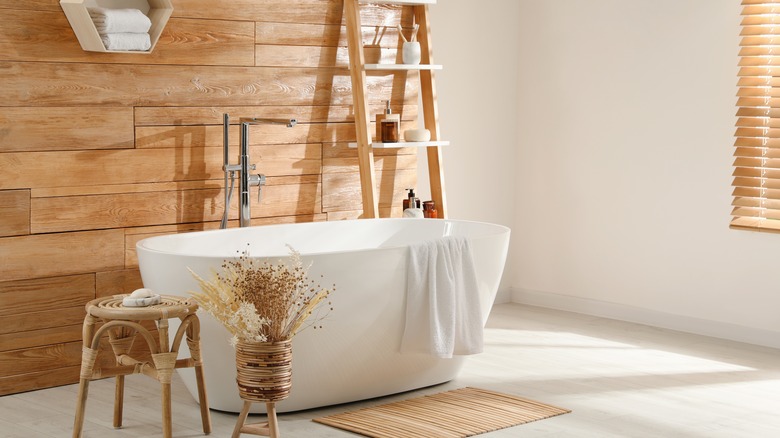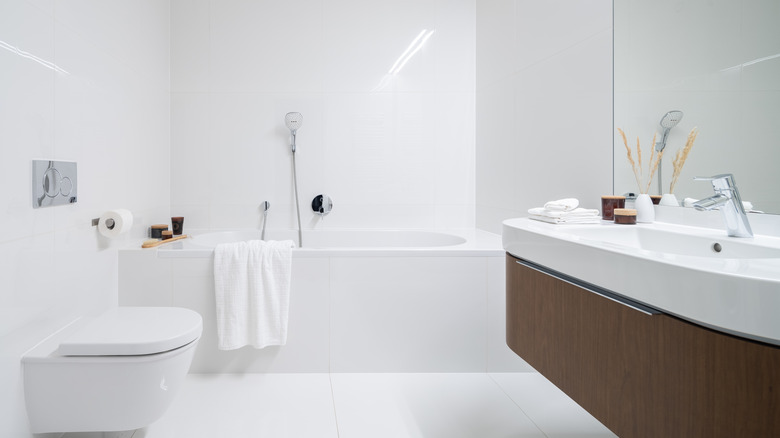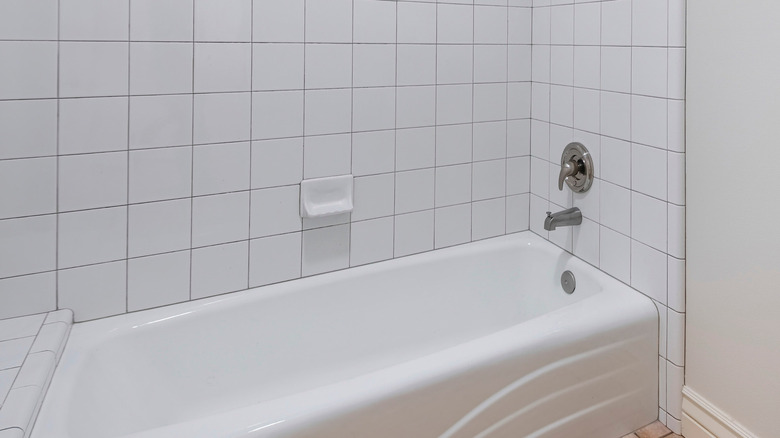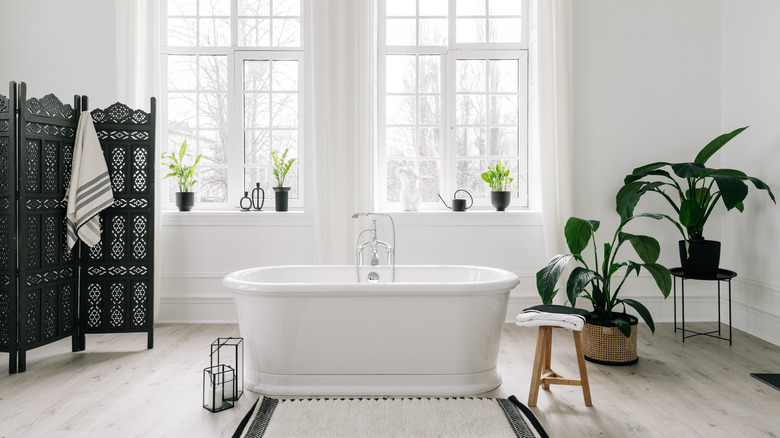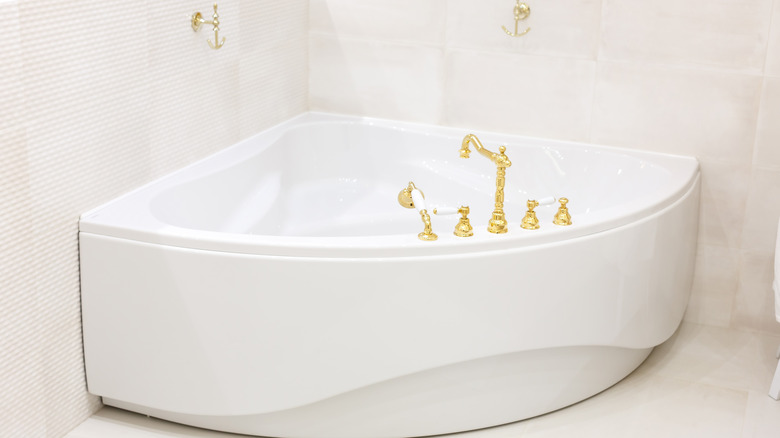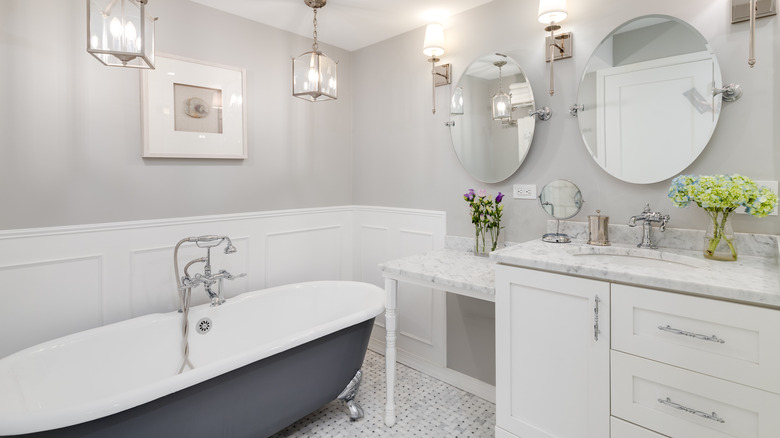5 Types Of Bathtubs That Will Look Good In Every Style Bathroom
There are those people who prefer a luxurious shower with plenty of space and all the high-end fixtures over a bathtub in their dream bathroom. However, if you're the type of person who likes to soak away the worries of the day in a bubble bath, a bathtub might be a non-negotiable component of your dream bathroom.
Not to mention, the bathtub is often the focal point of any bathroom, per Progress Kitchen & Bath. It's generally the largest appliance in the space, and the aesthetic of your bathtub plays a big role in how your overall bathroom looks and feels — just think of bathrooms you've seen with dated tubs that immediately age the space by decades.
There are a lot of things to consider when choosing your ideal new bathtub, from the material it's made of and how easy it is to clean to the metals incorporated in the fixtures to the size (if you're on the taller end of the height spectrum, you definitely want to make sure your bathtub is large enough for you to stretch out comfortably).
However, before you make any of those decisions, you have to first figure out what style of bathtub you want, and there are more options than you might think. Whether you love a vintage aesthetic or sleek, modern lines, there's a bathtub out there that suits your taste. Here are five types of bathtubs that will look good in any style bathroom.
Drop-in bathtubs
As the name suggests, a drop-in bathtub is one that is surrounded by some type of frame or structure — often tile, although a higher-end drop-in bathtub might be surrounded by stone or another luxe material. While in a large enough bathroom, they might be placed in a central spot, typically, they'll be nestled against the wall or tucked in a corner, as Laurysen Kitchens explains. This trait also means they're a bit more efficient with space, making them a good option for those with smaller bathrooms.
From an aesthetic perspective, while there may not be as much variation in the tub itself, the structure surrounding it can be customized to match the other materials in your bathroom, as per Quality Bath. Whether you select quirky, colorful tiles or sleek slabs of natural stone, the tub will blend seamlessly into your space. If budget is a big concern, that's another pro for drop-in tubs — they're often on the more affordable end of the price spectrum.
Finally, from a functionality perspective, you may get a bit of extra storage depending on the size of the frame surrounding the tub, and they're also a bit easier to clean since you only have to clean the interior of the bathtub and the structure around it rather than the exterior of the bathtub itself.
Alcove bathtubs
Though alternate styles like freestanding tubs are becoming more popular, there was a period when the alcove bathtub was pretty much the default bathtub in the average home. This style of bathtub has a fair bit in common with the drop-in style bathtub, and it's the perfect choice for those who want the best of both worlds in terms of a shower and a bath. While there are ways to install a shower component above other bathtub styles, this all-in-one solution is the simplest one for those who want the option to either bathe or shower.
As The Bathtubber highlights, alcove tubs do have restrictions in terms of where in your bathroom they can go — they need some type of wall on three sides, so they have to be nestled somewhere along the perimeter of your bathroom. However, this also means they're incredibly space-efficient, making them a great option for smaller bathrooms. Not to mention, while there are obvious variations in prices depending on the exact bathtub you select, alcove-style bathtubs are typically the most affordable style, a bonus for anyone creating their dream bathroom on a budget.
And, though many simply toss a curtain rod and shower curtain alongside one edge of an alcove tub and call it a day, there are options with sleek glass panels or other enclosures that allow you to get a more modern aesthetic, as per Innovate Building Solutions.
Freestanding bathtubs
If you have strong opinions about how you want your dream bathroom to look, there's a good chance you've at least considered a freestanding tub because they make a big style statement. There are options with curved edges, sleek square lines, and everything in between. As South End Plumbing outlines, the fact that designers don't have to consider wall placement means they can really think outside the box and create eye-catching styles.
Plus, unlike many of the other styles, freestanding bathtubs can be positioned virtually anywhere, allowing you to highlight particular architectural features — for example, placing them near a skylight or big window. And having room around them can actually make your bathroom feel a bit more spacious, as per Innovate Building Solutions.
Though they do tend to be more expensive on average, it's a bit less work to install them, as These Three Rooms reports. While you may need to install plumbing if it's not present in the specific spot you want the tub, you won't need to tile the wall around a freestanding bathtub like you would many built-in bathtubs.
The one major thing to consider is the material the bathtub is made of. As Bathroom Studio Design warns, freestanding tubs tend to be quite a bit heavier than other bathtub options, so you want to double-check that your flooring can actually support your chic new bathtub.
Corner bathtubs
In bathrooms that are low on space or have an unusual layout, the innovative solution of a corner bathtub might just be the right fit. As Quality Bath explains, their tucked-away spot in your bathroom can often provide a little more floor space around the other elements in the room, from sinks and counter space to toilets. This allows you to make the most of your bathroom's floor plan and makes it a bit easier to navigate in a somewhat cramped bathroom. Plus, it's possible to install a shower over the corner bathtub, as per Bathtubber, which means you don't need to squeeze a shower into the space in addition to your bathtub.
And those who want a little extra room in their bathtub may be tempted by this option, as larger variations are often quite spacious in terms of volume. However, this added capacity can be a downside in terms of the physical and visual space it takes up. According to High Shower, corner bathtubs can sometimes look a bit bulky, and while they do fill unused corners rather than take up space more centrally in your bathroom, they are typically larger than many other styles of bathtub.
Clawfoot bathtubs
Technically, clawfoot bathtubs are a type of freestanding bathtub –however, they're often considered a category of their own, both because of their distinctive aesthetic and their particular pros and cons.
One of the things that differentiate clawfoot bathtubs from freestanding varieties, as Streamline explains, is the fact that the bathtub is lifted on four feet, offering a glamorous, vintage vibe that many adore. Those who prefer that look can also find faucets with a similar aesthetic — as per Kingston Kitchen & Bath, they come in all kinds of materials, finishes, and styles, truly transforming your bathroom.
And, if you go for a classic cast iron variation, your bathtub will likely last for decades, if not longer, as per Rustic Sinks. Finally, like any freestanding bathtub, clawfoot bathtubs give you a ton of flexibility in terms of where you want to position the fixture in your space.
While the aesthetic appeal alone may convince many design enthusiasts, there are two things to consider in terms of practicality. Clawfoot tubs are perhaps the most difficult bathtubs to clean since you have to clean not only the interior and exterior but also the underside of the bathtub and the floor beneath it since they're raised several inches off the floor. And, if you've opted for a classic cast iron model, you need to consider the weight — a cast iron bathtub filled with water can weigh anywhere from 500 to 900 pounds, according to Streamline, which not every floor can support.
